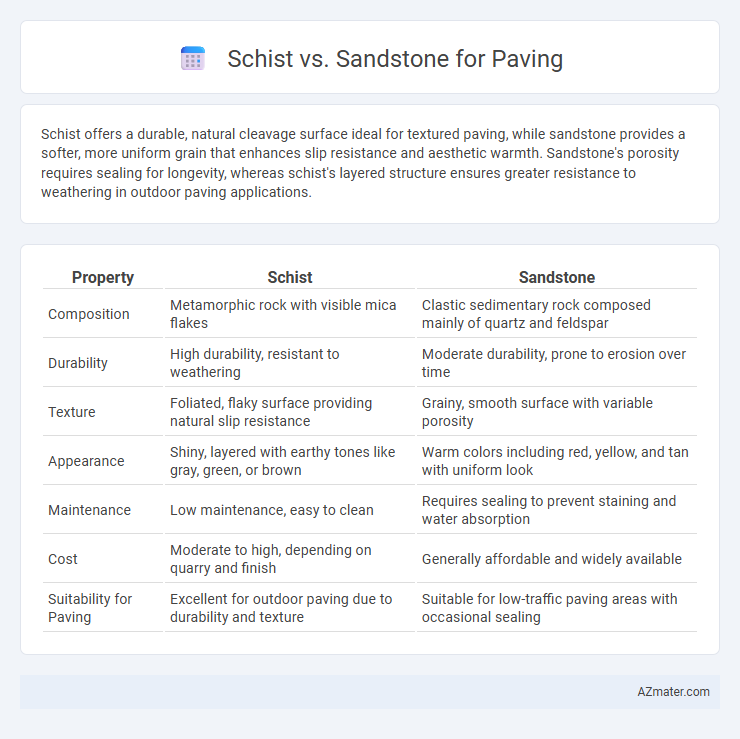Schist offers a durable, natural cleavage surface ideal for textured paving, while sandstone provides a softer, more uniform grain that enhances slip resistance and aesthetic warmth. Sandstone's porosity requires sealing for longevity, whereas schist's layered structure ensures greater resistance to weathering in outdoor paving applications.
Table of Comparison
| Property | Schist | Sandstone |
|---|---|---|
| Composition | Metamorphic rock with visible mica flakes | Clastic sedimentary rock composed mainly of quartz and feldspar |
| Durability | High durability, resistant to weathering | Moderate durability, prone to erosion over time |
| Texture | Foliated, flaky surface providing natural slip resistance | Grainy, smooth surface with variable porosity |
| Appearance | Shiny, layered with earthy tones like gray, green, or brown | Warm colors including red, yellow, and tan with uniform look |
| Maintenance | Low maintenance, easy to clean | Requires sealing to prevent staining and water absorption |
| Cost | Moderate to high, depending on quarry and finish | Generally affordable and widely available |
| Suitability for Paving | Excellent for outdoor paving due to durability and texture | Suitable for low-traffic paving areas with occasional sealing |
Introduction to Schist and Sandstone as Paving Materials
Schist and sandstone are popular natural stone options for paving due to their durability and aesthetic appeal. Schist offers a foliated texture with mineral grains that provide natural slip resistance, making it ideal for outdoor walkways and patios. Sandstone features a fine-grained texture and warm earthy tones, known for its weather resistance and ease of shaping, which enhances design flexibility in paving projects.
Geological Formation and Composition
Schist forms through regional metamorphism, characterized by its foliated texture due to aligned mica and quartz minerals, providing a durable yet flexible paving material. Sandstone originates from sedimentary processes, composed mainly of cemented quartz grains, offering a granular surface with moderate hardness suited for exterior pavements. The mineral composition of schist grants enhanced weather resistance and strength, while sandstone's porosity influences its slip resistance and maintenance requirements.
Appearance and Aesthetic Appeal
Schist offers a natural, textured surface with a shimmering, crystalline appearance due to its mica content, creating a rustic and visually dynamic paving option. Sandstone features a smoother, more uniform texture with warm earth tones ranging from beige to red, lending a classic and timeless aesthetic to outdoor spaces. Both materials provide distinct visual appeals, making schist ideal for a striking, rugged look and sandstone perfect for elegant, subtle paving designs.
Durability and Weather Resistance
Schist offers excellent durability and superior weather resistance due to its foliated structure and natural mineral composition, making it ideal for paving in regions with variable climates. Sandstone, while aesthetically appealing and relatively durable, can be more porous and susceptible to erosion and weathering over time, especially in freeze-thaw conditions. For long-lasting paving solutions, schist provides enhanced resilience against moisture, temperature fluctuations, and mechanical wear compared to sandstone.
Slip Resistance and Safety
Schist offers superior slip resistance for paving due to its naturally rough, foliated surface, reducing the risk of slips and falls in wet or icy conditions. Sandstone, while aesthetically pleasing, tends to be smoother and may require additional treatments to enhance traction for safety. Choosing schist for paving projects prioritizes durability and slip-resistance, making it ideal for high-traffic, outdoor areas where safety is a concern.
Installation and Maintenance Requirements
Schist requires careful installation due to its natural cleft surfaces and irregular thickness, which demand skilled labor to ensure stable, level paving with proper drainage. Sandstone offers easier installation with its uniform slabs that allow for quicker fitting and alignment, reducing labor time and cost. Maintenance of schist involves regular sealing and inspection to prevent flaking, while sandstone needs less frequent sealing but may require cleaning to avoid surface discoloration and moss growth.
Environmental Impact and Sustainability
Schist and sandstone both offer durable options for paving, but schist's natural foliation allows easier splitting, reducing energy consumption during quarrying and processing compared to the denser sandstone. Sandstone's porous structure tends to facilitate better water permeability, supporting sustainable urban drainage and reducing runoff. The environmental impact of both stones largely depends on responsible sourcing and local availability, with reclaimed or locally quarried materials significantly lowering carbon footprints.
Cost Comparison
Schist paving typically costs more due to its natural cleavage and unique texture, ranging from $15 to $30 per square foot, whereas sandstone is more affordable, averaging between $10 and $20 per square foot. Installation expenses for schist can also be higher since its irregular surfaces might require skilled labor and additional groundwork. Sandstone's uniformity allows for quicker, less costly installation, making it a budget-friendly option for large-scale paving projects.
Best Applications for Schist and Sandstone Paving
Schist, known for its foliated texture and natural cleft surface, excels in paving applications requiring slip resistance and aesthetic appeal in shaded garden paths or patios. Sandstone offers porous, durable qualities making it ideal for outdoor walkways and driveways exposed to heavy foot traffic and varying weather conditions. Choosing between schist and sandstone depends on the need for textured grip versus weather-resistant durability in paving projects.
How to Choose the Right Stone for Your Paving Project
Selecting the right stone for paving involves evaluating durability, texture, and aesthetic appeal, where schist offers a layered, slip-resistant surface ideal for high-traffic areas, while sandstone provides a smoother, warmer appearance suited for decorative pathways. Consider the climate and expected wear; schist's natural cleft surface withstands freeze-thaw cycles better, whereas sandstone may weather more quickly but can be easily restored. Budget and maintenance also impact choice, with sandstone generally being more affordable but requiring sealing, and schist offering low maintenance and long-lasting performance.

Infographic: Schist vs Sandstone for Paving
 azmater.com
azmater.com